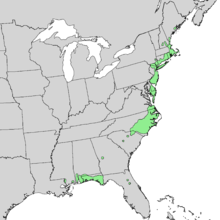Chamaecyparis thyoides
| Chamaecyparis thyoides | |
|---|---|

| |
| Chamaecyparis thyoides near the edge of a bog in New Jersey | |
| Scientific classification | |
| Kingdom: | Plantae |
| Clade: | Tracheophytes |
| Clade: | Gymnospermae |
| Division: | Pinophyta |
| Class: | Pinopsida |
| Order: | Cupressales
|
| Family: | Cupressaceae |
| Genus: | Chamaecyparis |
| Species: | C. thyoides
|
| Binomial name | |
| Chamaecyparis thyoides (L.) Britton, Sterns & Poggenb.
| |

| |
| Natural range of Chamaecyparis thyoides | |
Chamaecyparis thyoides (Atlantic white cedar, Atlantic white cypress, southern white cedar, whitecedar, or false-cypress), a species of
Distribution and habitat
Chamaecyparis thyoides grows within 100 miles of the coastline and less than 50 m above sea level[5] along much of the East Coast and Gulf Coast.[6] Rare populations grow in the foothills of the Appalachian Mountains, where the tree may be found up to 460 m above sea level.[2] Nationally, Atlantic white cedar is protected in the Great Dismal Swamp National Wildlife Refuge, Alligator River National Wildlife Refuge, Cape Cod National Seashore, Croatan National Forest, Francis Marion National Forest, Ocala National Forest, and Apalachicola National Forest. Altered fire regimes, logging, and draining of wetlands outside of the few protected areas have all contributed to the general decrease in the size and occurrences of Atlantic white cedar stands. The tree is listed as Rare in Georgia and New York, of Special Concern in Maine, and Extirpated in Pennsylvania.[5][7][8] In Mississippi, the species is at risk of extirpation as a consequence of overexploitation, changes in land use, and extreme weather events.[9]
Chamaecyparis thyoides lives almost exclusively in freshwater wetlands and is considered an obligate wetland species. It prefers habitats where the soil is saturated with water at least during the majority of the growing season. The soils in these regions have a thick organic layer, often classified as a histic surface horizon, with sandy material at greater depths and poor drainage. Atlantic white cedar wetlands are acidic and there is little oxygen stored in the soil because water has displaced the air. Plants that live in these environments must be specially adapted to such conditions.
Ecology
The trees themselves grow on
Description
Chamaecyparis thyoides is an
Subspecies variation
- Chamaecyparis thyoides thyoides: Leaves and immature cones usually glaucous blue-green; cones mature to dark brown-black; facial leaves flat, not ridged, but with visible glands.
- Chamaecyparis thyoides henryae: Leaves and immature cones green, not glaucous; cones mature to light brown; facial leaves with a longitudinal ridge with glands less obvious or absent.[2][5][8]
Cultivation and uses

Chamaecyparis thyoides is of some importance in horticulture, with several cultivars of varying crown shape, growth rates and foliage color having been selected for garden planting. Named cultivars include 'Aurea' (yellow foliage), 'Heatherbun' (dwarf, purple in winter),[13] 'Andelyensis' (dwarf, dense foliage), 'Ericoides' (juvenile foliage), and 'Glauca' (strongly glaucous foliage).[3] In some locations, particularly Mobile County, Alabama, the tree is cultivated as a Christmas tree.[14]
Wood
Its wood is considered hardy, as it is resistant to decay and warping in a variety of temperatures and moisture levels. The most common use of white cedar wood is lumber, for which stands usually require 70 years of growth from
Conservation
Prior to
Gallery
-
Chamaecyparis thyoides in bog habitat, Franklin Parker Reserve in New Jersey
-
Seedling
-
C. thyoides trunks in Franklin Parker Reserve
-
Close up of bark, Blue Hills Reservation in Massachusetts
References
- . Retrieved 12 November 2021.
- ^ ISBN 1-84246-068-4
- ^ ISBN 0-7470-2801-X.
- doi:10.1139/X04-125.
- ^ a b c d e "Plants Profile for Chamaecyparis thyoides". USDA Natural Resource Conservation Service.
- ^ "Chamaecyparis thyoides". Germplasm Resources Information Network. Agricultural Research Service, United States Department of Agriculture. Retrieved 12 December 2017.
- ^ .
- ^ a b c d e Laderman, AD (1989). "The ecology of the Atlantic white cedar wetlands: a community profile". US Fish and Wildlife Service Biological Report. 85 (7.21).
- ISSN 0015-749X.
- ^ Bright, S; Charny, V; Howell, WM (2013). "Butterflies: new records for Alabama". Journal of the Alabama Academy of Science. 84 (1): 37.
- ISBN 0-07-026570-4.
- ^ S2CID 12678061.
- ISBN 080141721X.)
{{cite book}}: CS1 maint: multiple names: authors list (link - ^ S2CID 3200627.
- ^ Peattie, Donald Culross. Trees You Want to Know. Whitman Publishing Company, Racine, Wisconsin, 1934 p31
- ^ Jetton, Robert; Whittier, W. Andrew (2019). "Effect of Seed Coat Sterilization and Photoperiod Treatments on the Germination of Atlantic White-Cedar Seeds" (PDF). Tree Planters' Notes. 62.





